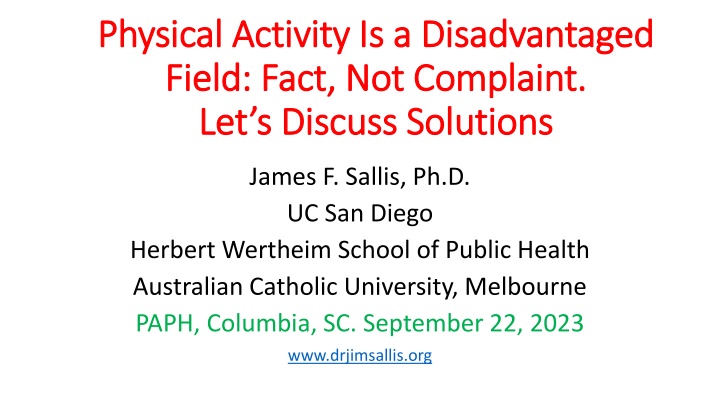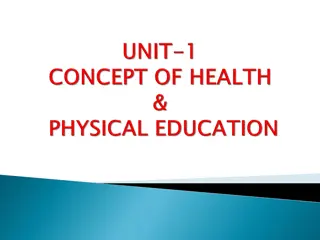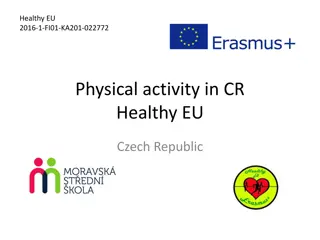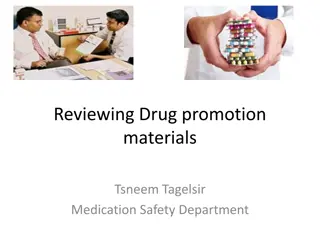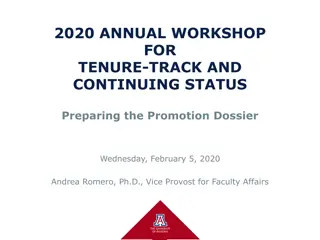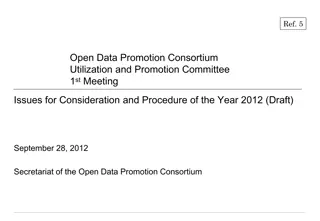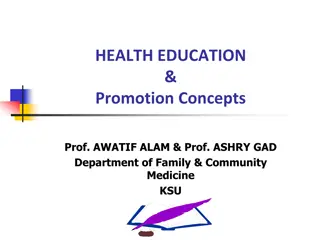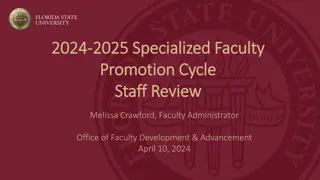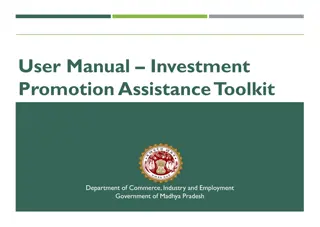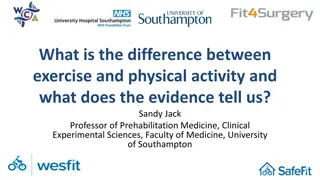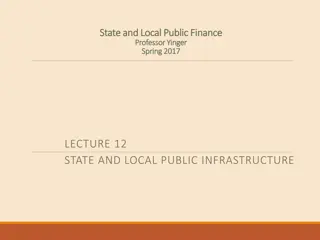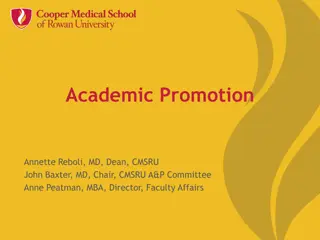Physical Activity in Public Health: Prioritizing Promotion and Infrastructure
The discussion focuses on the critical issues surrounding physical activity promotion, research funding, and infrastructure development to enhance public health outcomes. Highlighting trends, progress, and challenges in improving physical activity levels to address the significant health benefits it offers.
Download Presentation

Please find below an Image/Link to download the presentation.
The content on the website is provided AS IS for your information and personal use only. It may not be sold, licensed, or shared on other websites without obtaining consent from the author.If you encounter any issues during the download, it is possible that the publisher has removed the file from their server.
You are allowed to download the files provided on this website for personal or commercial use, subject to the condition that they are used lawfully. All files are the property of their respective owners.
The content on the website is provided AS IS for your information and personal use only. It may not be sold, licensed, or shared on other websites without obtaining consent from the author.
E N D
Presentation Transcript
Physical Physical Activity Is a Disadvantaged Activity Is a Disadvantaged Field Field: : Fact Fact, , Not Complaint. Not Complaint. Let s Discuss Solutions Let s Discuss Solutions James F. Sallis, Ph.D. UC San Diego Herbert Wertheim School of Public Health Australian Catholic University, Melbourne PAPH, Columbia, SC. September 22, 2023 www.drjimsallis.org
Outline We all know the overwhelming evidence of numerous physical, mental, and planetary health benefits of PA By some estimates PA is the fourth underlying cause of death in the US and worldwide prevalence of meeting guidelines is poor and not changing much PA promotion should be a public health priority This talk is a continuation of a long-term discussion about proper priority, funding, and infrastructure for PA research and practice Trends in funding and support for PA research Trends in capacity for PA promotion practice How can we increase the priority of PA in public health?
crystal_ball2 A Crystal Ball on Physical Activity and Health James F. Sallis, Ph.D. Presented to First International Conference on Physical Activity and Public Health Atlanta, GA, April 20, 2006
A seminal paper. Identifying critical issues. Demonstrating leadership.
2006 Signs of Progress, with updates: Building Infrastructure for PA Promotion PA Branch instituted at CDC in 1996 Staffing has declined PA Coordinators in all US states Not now PA & Public Health courses in US and internationally Funding is unreliable Thecommunityguide.org identifies effective multiple PA interventions Federal Carol White PEP grants funded PE improvements, but it was cancelled several years ago
2006 Signs of Progress, with updates: Measurement & Surveillance PA in CDC-sponsored surveillance systems Extensive efforts to broaden scope of PA surveillance to include the determinants of PA & more use of technology International PA Questionnaire (IPAQ) tested in 12 countries Now widely used IPAQ used in over 20 countries for first PA prevalence study with comparable measures, with 25 additional countries using GPAQ Over >160 countries now have national PA data Fitness measures & accelerometers used for first time with US population sample (NHANES) Problematic follow-up, with non-comparable accelerometer measures Fitness measures not repeated
Number of Scientific Articles Found in Web of Science Searches for Physical Activity and Exercise for 1995 and 2005 10000 9000 8000 7000 6000 5000 1995 4000 2005 3000 2000 1000 0 Physical Activity Exercise
2006, with updates: There is More Bad News There is no infrastructure for PA at NIH, only an occasional working group and several individual champions No change There are only 2 PA experts at WHO headquarters Now there is a PA office, with strong leadership (Fiona Bull) Most U.S. state health departments have only 1 person working on PA Most states have 0 now Progress on implementing evidence-based programs is very slow No change. See paper on scaling up by Reis et al in Lancet PA Series 2 (2016)
Number of NIH Grants in 1996 and 2005 with Physical Activity/Exercise in titles. Results of a CRISP search. 235 230 225 1996 220 2005 215 210 205 PA & Exercise
Number of NIH Grants in 1996 and 2005 with Physical Activity/Exercise or Alcohol in titles. Results of a CRISP search. +7.4% +25.7% 600 500 400 1996 300 2005 200 100 0 PA & Exercise Alcohol
Toni Yancey and I celebrate the 2009 Preventive Medicine issue on physical activity infrastructure
Physical Activity: Cinderella or Rodney Physical Activity: Cinderella or Rodney Dangerfield Dangerfield? Problems Identified. Responses? ? Problems Identified. Responses? Estimates of Funding for Various Diseases, Conditions, Research Areas on the NIH website February 5, 2008 [http://www.nih.gov/news/fundingresearchareas.htm]. There were 214 research areas (actually 360) for which funding amounts were listed, but physical activity, exercise, fitness, and sedentary behavior were not on the list. PROGRESS
Physical Activity: Cinderella or Rodney Physical Activity: Cinderella or Rodney Dangerfield Dangerfield? Problems Identified ? Problems Identified Responses? Responses? Dorfman and Yancey (2009) called for industries to assume responsibility for their contributions to the problem of inactivity auto, oil, tire, highway construction, film and TV production and distribution, and video gaming. Little or no progress on these particular industries. Substantial progress on research and collaboration on active transportation: AHA published a policy and evidence rationale (Circulation) Thanks to Laurie Whitsel ACSM Active Earth initiative Conference on Health & Active Transport (Transport. Research Board. December 2019. Recording & proceedings available.)
Yancey & Sallis, 2009 Recommendation A scientific infrastructure with committed and aggressive leadership is needed NIH should establish a committee or task force with the charge of developing a comprehensive research agenda for physical activity, along with recommendations for implementing the agenda that includes a permanent and high-level home for PA at NIH. Example: Office of Nutrition Coordination Action: None The National Physical Activity Plan recommends such an office at DHHS, but no action
Physical Activity in the Federal Government DHHS Office of Disease Prevention No office or person with full-time attention to PA Office of Disease Prevention coordinated the PA Guidelines Thank you, Katrina Pearcy! President s Council for Fitness, Sports, and Nutrition (approx. $1M budget) CDC Division of Nutrition, Physical Activity, and Obesity Congressional budget has 8 funding lines for the Division All lines are related to nutrition or obesity topics/programs No dedicated budget line for PA Physical Activity and Health Branch PAHB is the primary government entity responsible for PA surveillance and promotion In 1997, 50 states had PA Coordinators In 2023, 17 states had PA Coordinators
CDC Physical Activity and Health Branch: Estimated FTEs Over Time 40 35 30 25 20 15 10 5 0 1996 2004 2008 FTEs 2020 2023
Non-Profit Sector PA Section of APHA is only 14 years old one of the youngest An effort to create a PA program in the National Academy of Medicine failed to raise sufficient funds 3 small, poorly-funded PA organizations merged to create a larger but still poorly-funded PA organization. But PA now has a cohesive voice. National Coalition for Promoting Physical Activity + National Physical Activity Plan + Physical Activity Society = Physical Activity Alliance
My recommendations at the 2006 Physical Activity & Health Conference Conduct research that will inform us how to reach physical activity goals in each country Dissemination & implementation research has grown Join with other groups to build a movement for physical activity promotion Infrastructure for PA promotion still lacking Become vocal & persistent advocates for effective PA interventions Share Evidence with those who can use it Join with others to advocate. Speak Up. It is up to your generation to improve capacity for PA promotion. What are your ideas about how to make progress?
